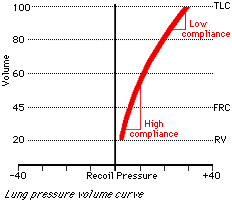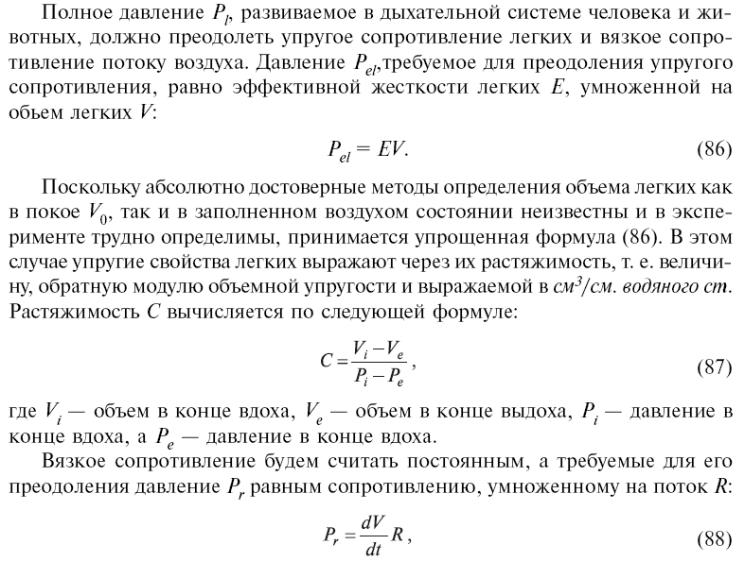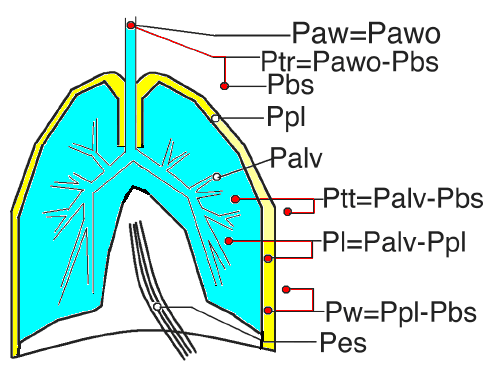
- •Медицинские приборы. Разработка и применение.Джон г. Вебстер, Джон в. Кларк мл., Майкл р. Ньюман, Валтер х. Олсон и др. 652 стр., 2004 г., глава 9.
- •Forced Expiration
- •Table 64-2. Characteristic changes in several disorders
- •Obstructive Ventilatory Defect
- •Alveoli
- •Bronchitis
- •Chest Wall
- •Compliance
- •Принципы моделирования патологически изменённых спирограмм в мс-9
Chest Wall
|
|
The chest wall consists of all the anatomical structures which surround the lungs and pleura, including the intercostals, the ribs, and the diaphragm.
When the chest wall is relaxed (and only when it is relaxed), it behaves as an elastic container, similar to the lung. The pressure difference across the chest wall, Pw (pleural pressure minus the pressure at the body surface), determines its size. In the absence of any pressure difference (Ppl=0 and Pw=0), the chest wall would come to itsunstressed volume, which is roughly 75% of Total Lung Capacity. When the pleural pressure is below atmospheric (Pw is negative), the chest wall is pulled inward.
When the pleural pressure rises aboveatmospheric pressure (Pw is positive), the chest wall bows out. Again, however, it is important to understand that these conditions only hold when the chest wall muscles are relaxed (during quiet expiration, certain states of paralysis or anesthesia, and whenthe respiratory muscles are consciously relaxed). The pressure difference across the chest wall will have no relationship to its size if the respiratory muscles are being used either to move the chest or to keep it at a particular volume.
In certain disease states the chest wall may stiffen. In such cases, a restrictive ventilatory defect may result.

Compliance
Compliance refers to the distensibility of an elastic structure (such as the lung) and is defined as the change in volume of that structure produced by a change in pressure across the structure. It is important to understand that the lung (or any other elastic structure) will not increase in size if the pressure within it and around it are increased equally at the same time.

In a normal healthy lung at low volume, relatively little negative pressure outside (or positive pressure inside) needs to be applied to blow up the lung quite a bit. However lung compliance decreases with increasing volume. Thereforeas the lung increases in size, more pressure must be applied to get the same increase in volume. This can be seen from the following pressure-volume curve of the lung: Lung compliance and the slope are the same:
Compliance can also change in various disease states. For example, in fibrosis the lungs become stiff, making a large pressure necessary to maintain a moderate volume. Such lungs would be considered poorly compliant. However, in emphysema, where many alveolar walls are lost, the lungs become so loose and floppy that onlya small pressure difference is necessary to maintain a large volume. Thus, the lungs in emphysema would be considered highly compliant.

![]()

V
П

V
олучаем такое ДУ: ,
,
соответствующее
ПФ:
 .
.
Если учесть ещё инерционные силы, действующие на массу перемещаемого при дыхании воздуха то получим линеаризованное в точке V=V0 , r=const уравнение [т.к. на самом деле: M(t)=r(t)×V(t), R=R(V), C=C(P)]:
 ,
,
Соответствующая
ПФ:
 (91)
(91)
Как правило, z>1, и поэтому ПФ равна:

 .
(92)
.
(92)
Мы воспользуемся формулой (92) для простоты положив z=1.


